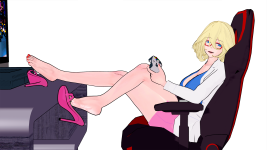Aerisetta
Active member
Hi,
Here is my situation and my issue. This is more of a commission request.
The games I make usually include a lot of cut scenes like a visual novel. Those cutscenes have images. The images are made in full 32 bit transparent PNGs.
Right now, in order to overcome the challenge of the game not accepting the PNGs as is, I need to take many steps
1. go into gimp
2. add stroke (to prevent weird outlines when it changes to 256 color)
3. add transparent background color
4. change to 256 colors
5. rearrange the color map to set transparent color
6. make 0 0 0 black not black
I need to do this repeatedly for each image, 100+ images a week (sometimes can batch) In the end, the result is something of lower quality, and I am also purposely avoiding the use of gradients because the result of those is something wonky.
This is something that really hampers my workflow, if the engine can just accept transparent PNGs, it will cut down my workload many hours per week.
I know I make "unconventional" games and this is not how most people use the engine, I don't know how much time or changes to the engine it would require...so I will be very happy to discuss this as a commission and pay for whatever time it takes.
There is also the technical issue of file size. I actually do not care about storage size, BUT i am worried the game cannot handle loading all these larger files. Something to figure out.
This is an example image.

I need to turn it into this

Here is my situation and my issue. This is more of a commission request.
The games I make usually include a lot of cut scenes like a visual novel. Those cutscenes have images. The images are made in full 32 bit transparent PNGs.
Right now, in order to overcome the challenge of the game not accepting the PNGs as is, I need to take many steps
1. go into gimp
2. add stroke (to prevent weird outlines when it changes to 256 color)
3. add transparent background color
4. change to 256 colors
5. rearrange the color map to set transparent color
6. make 0 0 0 black not black
I need to do this repeatedly for each image, 100+ images a week (sometimes can batch) In the end, the result is something of lower quality, and I am also purposely avoiding the use of gradients because the result of those is something wonky.
This is something that really hampers my workflow, if the engine can just accept transparent PNGs, it will cut down my workload many hours per week.
I know I make "unconventional" games and this is not how most people use the engine, I don't know how much time or changes to the engine it would require...so I will be very happy to discuss this as a commission and pay for whatever time it takes.
There is also the technical issue of file size. I actually do not care about storage size, BUT i am worried the game cannot handle loading all these larger files. Something to figure out.
This is an example image.

I need to turn it into this

